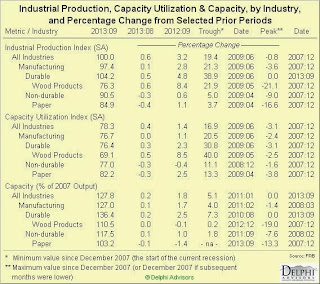Click image
for larger view
Because
the Census Bureau is delaying the release of September’s new residential sales
data until December 4 (when it will be combined with October’s data), this post
will contain references to just existing home sales and prices.
Existing home sales
decreased (by 100,000 units or 1.9 percent) to 5.29 million units (SAAR )
in September. The median price of previously owned homes sold in September dropped
by $10,500 or 5.0 percent), to $199,200. The number of existing homes for sale
remained stable but months of inventory increased by 0.1 month.
Click image
for larger view
Although
the median price of existing homes for
sale fell slightly in August ($800 lower than in July), housing affordability
continued to erode because of rising mortgage interest rates and stagnant
median family incomes. Concurrently, Standard & Poor’s
reported that both the 10- and 20-City Composites in the S&P/Case-Shiller Home
Price indices posted not-seasonally adjusted monthly gains of 1.3 percent in August
(12.8 percent relative to a year earlier). Dallas ,
TX Denver ,
CO
Click image
for larger view
The foregoing comments represent the
general economic views and analysis of Delphi Advisors,
and are provided solely for the purpose of information, instruction and
discourse. They do not constitute a solicitation or recommendation regarding
any investment.



































